
Yerranderie is a ghost town located near Kanangra-Boyd National Park in New South Wales, Australia in Wollondilly Shire. [1]

Yerranderie is a ghost town located near Kanangra-Boyd National Park in New South Wales, Australia in Wollondilly Shire. [1]
Yerranderie was formerly a silver mining town of 2000 people, but the mining industry collapsed in 1927, and the town was cut off from direct access from Sydney by the establishment of the Warragamba Dam and Lake Burragorang in 1959. Country singer Frank Ifield immortalised the event with his song “Yerranderie”. The Yerranderie Post Office opened on 1 November 1899 and closed in 1958. [2]
The town is now divided into two sections, the residential township adjacent to a private airstrip and the historic site one kilometre further west. The area is surrounded by abandoned mine shafts and mining relics. Accessible mainly by dirt road from Oberon, New South Wales 70 km to the west; another route passes through Oakdale, New South Wales to the east, but that road is closed to public access as it passes through a water catchment area. [3] Aircraft also occasionally fly out from Camden Airport. The township was established on the slopes north of Yerranderrie Peak, which is the remains of a volcanic dyke and the source of the mineral wealth of the area. The name of Yerranderrie is taken from two local Aboriginal words meaning "slope" and "summit".
Yerranderie was caught up in what was, at the time, the world's longest strike, lasting for eighteen months in 1919–1920. [4] The workers of this small mine belonged to the same union as those at Broken Hill. When the Broken Hill mine went on strike, the workers at Yerranderie were required to join that strike by their union. The strike, however, was not about any issue at Yerranderie.
The town was eventually bought by Valerie Anne Lhuede, who developed it as a tourist centre and total environment project. The old post office is now known as The Lodge and serves as a guest house. Other restored buildings include two miners cottages as well as several shops. The caretakers live in Krubi Cottage nearby. [5]
In March 2011, Lhuede announced, "I am donating Yerranderie to the National Parks and Wildlife Service with a list of my wishes for Yerranderie’s future."[ citation needed ]

Heathcote National Park is a protected national park that is located in the southern area of Sydney, New South Wales in eastern Australia, and is situated on Dharawal country. The 2,679-hectare (6,620-acre) national park is situated approximately 35 kilometres (22 mi) southwest of the Sydney central business district, west of the Illawarra railway line, the Princes Highway and Motorway, and the suburbs of Heathcote and Waterfall.

Ku-ring-gai Chase National Park is a national park on the northern side of Sydney in New South Wales, Australia. The 14,977-hectare (37,010-acre) park is 25 kilometres (16 mi) north of the Sydney central business district and generally comprises the land east of the M1 Pacific Motorway, south of the Hawkesbury River, west of Pittwater and north of Mona Vale Road. It includes Barrenjoey Headland on the eastern side of Pittwater.

The Nattai National Park is a protected area located in the Macarthur and Southern Highlands regions of New South Wales, Australia. The 48,984-hectare (121,040-acre) area is situated approximately 150 kilometres (93 mi) southwest of the Sydney central business district and primarily encompasses the valley of the Nattai River, which is surrounded by sandstone cliffs. Part of the Southern Highlands Shale Forest and Woodland, the park is covered in dry sclerophyll (hard-leafed) forest – mostly eucalypt, and has frequent forest fires. As of May 2024, the park has no facilities.
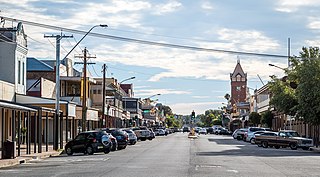
Broken Hill is a city in the far west region of outback New South Wales, Australia. An inland mining city, it is near the border with South Australia on the crossing of the Barrier Highway (A32) and the Silver City Highway (B79), in the Barrier Range. It is 315 m (1,033 ft) above sea level, with a cold semi-arid climate, and an average rainfall of 265 mm (10.4 in). The closest major city is Mildura, 300 km (190 mi) to the south and the nearest State Capital City is Adelaide, the capital of South Australia, which is more than 500 km (310 mi) to the southwest and linked via route A32, the Barrier Highway.

Bulli is a northern suburb of Wollongong situated on the south coast of New South Wales, Australia.

Cobar is a town in central western New South Wales, Australia whose economy is based mainly upon base metals and gold mining. The town is 712 km (442 mi) by road northwest of the state capital, Sydney. It is at the crossroads of the Kidman Way and Barrier Highway. The town and the local government area, the Cobar Shire, are on the eastern edge of the outback. At the 2016 census, the town of Cobar had a population of 3,990. The Shire has a population of approximately 4,700 and an area of 44,065 square kilometres (17,014 sq mi).

Mittagong is a town located in the Southern Highlands of New South Wales, Australia, in Wingecarribee Shire. The town acts as the gateway to the Southern Highlands when coming from Sydney. Mittagong is situated at an elevation of 635 metres (2,083 ft). The town is close to Bowral, Berrima, Moss Vale and the Northern Villages such as Yerrinbool and Colo Vale. Moreover, Mittagong is home to many wineries of the Southern Highlands which has been a recent growing wine and cellar door region.

Mongarlowe is a village in the Southern Tablelands of New South Wales, Australia in Queanbeyan-Palerang Regional Council. In former times, it was also known, in various contexts, as Little River, Monga, and Sergeants Point. The name, Mongarlowe, also applies to the surrounding area, for postal and statistical purposes.
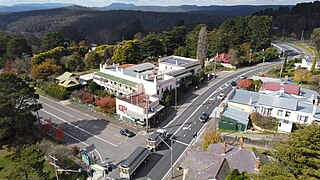
Mount Victoria is a village in the Blue Mountains of New South Wales, Australia. Geographically, Mount Victoria is the westernmost village and suburb of Greater Sydney on the Great Western Highway in the City of Blue Mountains, located about 120 kilometres (75 mi) west-northwest by road from the Sydney central business district and at an altitude of about 1,052 metres (3,451 ft) AHD. At the 2021 Census, the settlement had a population of 945.

Hill End is a former gold mining town in New South Wales, Australia. The town is located in the Bathurst Regional Council local Government area.

Ivanhoe is a very small township on the Cobb Highway between the Lachlan and Darling rivers in western New South Wales, Australia. It is located within the Central Darling Shire local government area. Ivanhoe functions as a service centre for the surrounding area. The township is characterised by a particularly wide high street. At the 2021 census, Ivanhoe had a population of 162.
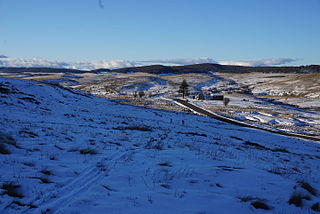
Kiandra is an abandoned gold mining town and the birthplace of Australian skiing. The town is situated in the Snowy Mountains of New South Wales, Australia, in the Snowy Monaro Regional Council inside the Kosciuszko National Park. Its name is a corruption of Aboriginal 'Gianderra' for 'sharp stones for knives'. It was earlier called Gibson's Plains, named after a Dr. Gibson, a settler in the district in 1839. For a century, Kiandra was Australia's highest town.

Bullaburra is a small town in the state of New South Wales, Australia, in the City of Blue Mountains. It is one of the towns that stretch along the route of the Main Western railway line and Great Western Highway which pass over the Blue Mountains, west of Sydney. Bullaburra used to have a service station but it was demolished in 2008. Bullaburra is an Aboriginal word meaning clear day.
The Macdonald River is a perennial river located in the Hunter and Outer Metropolitan Sydney regions of New South Wales, Australia. It is a part of the Hawkesbury-Nepean catchment.
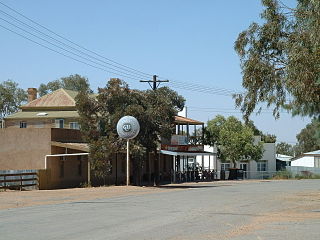
Tibooburra is a town in the far northwest of New South Wales, Australia, located 1,187 kilometres (738 mi) from the state capital, Sydney. It is most frequently visited by tourists on their way to Sturt National Park or on the way to or from Innamincka in South Australia and Birdsville in Queensland. At the 2016 census, Tibooburra had a population of 134. Although facilities in Tibooburra are quite limited, fuel, meals, and a range of accommodation options are available. All significant support services are based in Broken Hill.

The Oaks is a town in the Macarthur Region of New South Wales, Australia in Wollondilly Shire on the south western edge of the Sydney Basin. The Oaks is located 82 kilometres (51 mi) south-west of Sydney via the Hume Highway, 13 kilometres (8 mi) west of Camden and 290m above sea-level. At the 2016 census, The Oaks and the surrounding area had a population of 2,525.
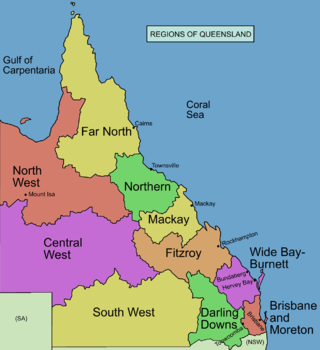
The Gulf Country or North West Queensland is the region of woodland and savanna grassland surrounding the Gulf of Carpentaria in north western Queensland and eastern Northern Territory on the north coast of Australia. The region is also called the Gulf Savannah. The Gulf Country is crossed by the Savannah Way highway.

Hill End Historic Site is a heritage-listed former gold rush town and now township at Hill End, Bathurst Region, New South Wales, Australia. It was added to the New South Wales State Heritage Register on 2 April 1999.
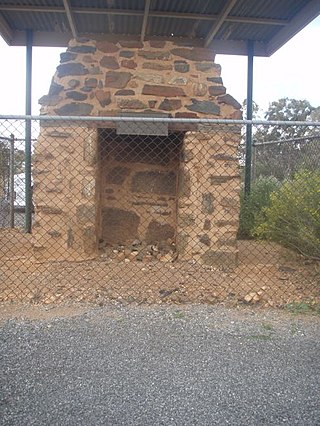
The First BHP Offices Chimney Ruin is the heritage-listed ruin of the original offices of BHP, now located on Willyama Common, east of the corner of Gaffney and Oxide Streets, Proprietary Square, Broken Hill, City of Broken Hill, New South Wales, Australia. The original offices were built in 1885 by Tom Phin and A. W. B. Orman. It is also known as Site of first BHP Offices, BHP Fireplaces and Chimney ruins. The property is owned by Broken Hill City Council. It was added to the New South Wales State Heritage Register on 23 April 2010.

Catherine Hill Bay Cultural Precinct is a heritage-listed company town at Catherine Hill Bay in the Hunter Region of New South Wales, Australia. It was added to the New South Wales State Heritage Register on 5 November 2010.